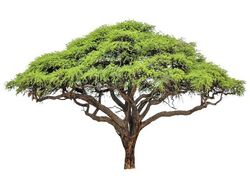| Johann Baptist Isenring’s Acacia Tree | |
|---|---|

| |
|
Origin |
Johann Baptist Isenring |
|
Type |
Acacia tree (Vachellia nilotica) |
|
Effects |
Colors the uncolored. |
|
Downsides |
Constant excretion of excess sap. |
|
Activation |
Contact with leaves. |
|
Collected by |
|
|
Section |
|
|
Aisle |
Arbor-41072E |
|
Date of Collection |
November 12, 1849 |
| [Source] | |
Origin[]
Johann Baptist Isenring (1796–1860) was a Swiss painter, printmaker and daguerreotypist. In 1840 or 1841 he produced the first coloured daguerreotype using a mixture of gum arabic and pigments. The coloured powder was fixed on the delicate surface of the daguerreotype by the application of heat. The result was one of the earliest examples of hand-colouring in photography.
Gum arabic, also known as acacia gum, is a natural gum consisting of the hardened sap of various species of the acacia tree. Originally, gum arabic was collected from Acacia nilotica which was called the "gum arabic tree".
Effects[]
Whenever something uncolored, such as an old photograph, comes into contact with the leaves of the tree, color will slowly spread from the point of contact until the entire subject is colored. Uncolored photographs will be given colors that match the real colors of the subjects within, effectively making the photograph as if it had been taken with colored film in the first place. In instances where something was designed specifically uncolored (excluding photographs), or were made specifically without colors (e.g. a black-and-white animation reel), colors that best suit the subject will be applied.
Artifact Math[]
The leaves of this accidentally came into contact with Henri Cartier-Bresson's Photograph after the latter was collected while both were in the Ovoid Quarantine, and the photograph was permanently colored as a result.
